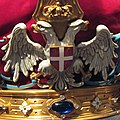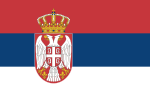The Royal Crown of Serbia (Serbian: Српска краљевска круна, romanized: Srpska kraljevska kruna) is a royal regalia that existed during the Serbian monarchy.
Serbia, like most former monarchies in Europe, has had crowns once worn by its rulers. The various Serbian principalities and kingdoms were organised around a number of different royal dynasties. Many of these invested in symbols of royalty which has led to a number of distinctive crowns, jewels and other treasures of incredible wealth surviving to the present day. As far as is known, there are four royal crowns once worn by Serbian kings or princes that have survived to the present day, of which just one is kept in the modern Republic of Serbia today.
Nemanjić Crowns
The Nemanjić Crown Jewels are the oldest of the surviving pieces of Serbian royal regalia. They were used in the coronation ceremonies of members of the medieval House of Nemanjić. Most of the original Nemanjić crown jewels were lost or are located in foreign countries. Many Serbian royal valuables ended up in Austria, Hungary, United Kingdom, Germany, Montenegro, Turkey, and Russia. Fleeing from the Turks, Serbian princes and lords, together with the clergy and the people, when they came to southern Hungary, carried with them their movable property, which not infrequently contained the ruler's insignia and valuables. Valuables kept for generations have thus found their final destination in the palace treasuries and collections of Western Europe. Many Serbian officers and dignitaries left their movable properties, by marriage and sale, in the hands of Hungarians and Germans, mostly residents of Vienna and Pest. But not only the Serbian medieval heritage, but also the heritage of the Serbs, Austrian subjects, who showed great cultural and economic progress in their new homeland, flowed for centuries, slowly, to Vienna and Budapest. This happened especially after the liberation of Hungary from the Turks, when Vienna and Pest developed rapidly. Retired high-ranking border officers of Serbian nationality immigrated to these two cities for two centuries, bringing with them many valuable possessions. Likewise, many Germans and Hungarians, generals and other officers, who served in the midst of Serbs, came to Vienna and Budapest, carrying entire caravans of almost everything that represented of value.
The 14th Century Crown of King Stefan Uroš III Dečanski Nemanjić is kept at Cetinje Monastery in Montenegro. Originally the crown was in possession of the Metropolitanate of Karlovci and was later gifted to Metropolitan of Cetinje, Petar I Petrović-Njegoš. The last time the crown was used was during the coronation of King Nikola I Petrović-Njegoš in 1910.
At the Kaiserliche Schatzkammer, a crown once worn by members of the medieval Nemanjić dynasty can be found which was later attributed to Stephen Bocskai, given by Ottoman Grand Vezir Sokolluzade Lala Mehmed Pasha on 11 November 1605 in Roško Polje. The second crown of Stephen Bocskai would end up in the possession of the Budapest museum. Together with these is a golden mantle (buckle) of unknown origin which is believed to have been captured by the Serbs from the Ottomans at Brasov.
There are accounts that the crown of Hohenstaufen in Germany, also of Byzantine design, has Serbian origins and that it might have belonged to one of Serbia's medieval rulers. Due to the impossibility of testing, it is impossible to prove it.
-
 Crown of Serbian King Stefan Uroš III Dečanski Nemanjić in Cetinje Monastery in Montenegro
Crown of Serbian King Stefan Uroš III Dečanski Nemanjić in Cetinje Monastery in Montenegro
-
 Crown of Stephen Bocskai in Kaiserliche Schatzkammer (Imperial Treasury) at the Hofburg in Vienna, Austria
Crown of Stephen Bocskai in Kaiserliche Schatzkammer (Imperial Treasury) at the Hofburg in Vienna, Austria
Karađorđević Crown
The Karađorđević Crown Jewels were created in 1904 for the coronation of King Peter I. The pieces were made from materials that included bronze taken from the cannon Karađorđe used during the First Serbian Uprising. This gesture was symbolic because 1904 was the 100th anniversary of that uprising. The regalia was made in Paris by the famous Falise brothers jewellery company. The crown and the rest of the regalia are in the Historical Museum of Serbia in Belgrade. Until 1904 they were at the altar of the Royal Chapel of St. Andrew the First-Called which is at the Royal Compound in Dedinje. The crown is currently the only Serbian crown kept in Serbia.
-
 Karađorđević Crown
Karađorđević Crown
-
 Coat of arms of Serbia on the crown
Coat of arms of Serbia on the crown
-
 King Peter I wearing the regalia, 1904
King Peter I wearing the regalia, 1904
-
 King Peter I's coronation, 1904
King Peter I's coronation, 1904
-
 Coat of arms of the Kingdom of Serbia
Coat of arms of the Kingdom of Serbia
-
 Coat of arms of the Kingdom of Serbs, Croats and Slovenes / Kingdom of Yugoslavia
Coat of arms of the Kingdom of Serbs, Croats and Slovenes / Kingdom of Yugoslavia
-
 Prince Peter holding the Karađorđević Crown (2013)
Prince Peter holding the Karađorđević Crown (2013)
-
 Prince Philip placing the Royal Orb near the Karađorđević Crown, 2013
Prince Philip placing the Royal Orb near the Karađorđević Crown, 2013
Regalia
The Karađorđević Royal Regalia consist of the following:
- Royal crown (Also known as the Karađorđević Crown), with details such as the Serbian coat of arms and monde
- Royal orb
- Royal scepter
- Royal mantle buckle
- Royal mantle
The crown, scepter, and orb are decorated with gemstones found in Serbia and enameled in the national colours of red, blue, and white. The royal mantle is made of purple velvet, embroidered with gold and lined with ermine fur. Unlike in most European countries' regalia, there is no sword of state.
-
 Serbian Crown Jewels, Karađorđević Crown, Royal orb and sceptre, and Royal Mantle buckle
Serbian Crown Jewels, Karađorđević Crown, Royal orb and sceptre, and Royal Mantle buckle
-
 Serbian Crown Jewels, Karađorđević Crown, Royal orb, and Royal Mantle buckle
Serbian Crown Jewels, Karađorđević Crown, Royal orb, and Royal Mantle buckle
-
 Serbian scepter
Serbian scepter
-
 Serbian Royal mantle
Serbian Royal mantle
-
 Serbian Royal mantle
Serbian Royal mantle
-
 Ermine fur on the Serbian Royal mantle
Ermine fur on the Serbian Royal mantle
Replica Crowns

By the initiative of dr Dušica Bojić [sr], the director of the Historical Museum of Serbia, with the support of the Ministry of Culture of Serbia, several crowns of medieval Serbian rulers were ideally recreated by the filigree artist Goran Ristović Pokimica (co-operated with other jewellers, filigree artists and goldsmiths) and aided by Dragan Vojvodić [sr], historian and professor of medieval artwork and the corresponding member of the Serbian Academy of Sciences and Arts. The crowns were made of silver, which were gilded with nickel and gold. All the pearls are genuine from freshwater sources, while the precious stones were grown from dust under artificial conditions. About 13 techniques were used during the construction and everything was done the old-fashioned way. Each crown is worked between four and six months. They were officially revealed to the public in December 2022. The crowns were temporarily displayed in the Historical Museum of Serbia between February and March 2023. They are planned to be permanently displayed at the newly planned museum location, previously the Belgrade Main railway station.
The first crown recreated was of King Stefan Uroš II Milutin Nemanjić, recreated from the fresco depictions in the King's Church of Studenica Monastery. Weighing in at 1.6 kilograms, the crown is adorned with 26 rubies, 18 sapphires, 23 amethysts, 4 lapis lazulis and 407 pearls. The production of the crown took four months, and the author used 13 techniques: rolling, cutting, forging, twisting, granulation, hand engraving, filigree, riveting, soldering, polishing, gilding, stone processing and faceting. Special care was given to make the crown of Stefan Dušan more elaborate and richer compared to Stefan Milutin′s, more fit for his Emperor status. Serbian rulers had several crowns during their reign, with Stefan Milutin′s crown as depicted in the frescoes in Gračanica Monastery being the most elaborate from all the depictions of the ruler.
Second crown recreated was of Emperor Stefan Uroš IV Dušan Nemanjić, recreated from the fresco depictions in Lesnovo Monastery. Weighing in at 1.7 kilograms, the production of the crown took six months, also using the same 13 techniques.
The third crown recreated was of Prince Stefan Lazarević, recreated from the fresco depictions in Manasija Monastery. Weighing in at 1.4 kilograms (1434.37 grams), the crown is adorned with 3 obsidians, 13 tourmalines, 3 aquamarines, 3 garnets, 4 amethysts, 26 rubies, 29 sapphires and 69 pearls. While the original crown was most likely made of gold or glam silver, the replica was made of gilded silver.
The crown of Empress Helena of Bulgaria, Emperor Stefan Dušan′s wife, was done by Jasminka Brkanović and was also recreated from the fresco depictions in Lesnovo Monastery. Due to the needs of the permanent display of the historical museum, the crown of Queen Helen of Anjou, wife of King Stefan Uroš I Nemanjić and mother of King Uroš II Milutin Nemanjić, was recreated from the fresco depictions in Sopoćani Monastery by Simon and Marsel Čivljak.
There are plans to ideally reconstruct crowns of over 20 medieval Serbian rulers, starting from King Mihailo I Vojislavljević all the way to Despot Đurađ Branković. By June 2023, Simon and Marsel Čivljak would recreate the crown of Queen Simonida Nemanjić, wife of King Stefan Uroš II Milutin Nemanjić, from the fresco depictions in the King's Church of Studenica Monastery, as well as the crown of King Mihailo I Vojislavljević, from the fresco depictions in the Church of St. Michael in Ston.
-
 Crown of Serbian Queen Simonida (recreated)
Crown of Serbian Queen Simonida (recreated)
-
 Crown of Serbian Emperor Stefan Uroš IV Dušan Nemanjić (recreated)
Crown of Serbian Emperor Stefan Uroš IV Dušan Nemanjić (recreated)
-
 Crown of Serbian Prince Stefan Lazarević (recreated)
Crown of Serbian Prince Stefan Lazarević (recreated)
See also
References
- ^ "Српске круне - Сачуване и нестале круна краља Стефана Дечанског". dinastijanemanjic.weebly.com (in Serbian). 19 January 2017. Retrieved 30 September 2023.
- Cetinje
- Fessler, Ignaz Aurelius (1815–1825). Die Geschichten der Ungarn und ihrer Landsassen. Leipzig.
- "The Regalia". Royal Family of Serbia. 21 December 2013. Retrieved 2019-01-03.
- ^ Petrović, Milana (6 February 2023). "Kako su izgledale krune srpskih vladara iz srednjeg veka? Istorijski muzej Srbije oživljava slavnu prošlost". nationalgeographic.rs (in Serbian). Retrieved 30 September 2023.
- ^ "Krune srpskih vladara kriju raskoš i bogatu istoriju". rts.rs (in Serbian). 21 January 2023. Retrieved 30 September 2023.
- ^ "Srbija i istorija: Kako su izgledale krune srednjovekovnih vladara". bbc.com (in Serbian). 10 January 2023. Retrieved 30 September 2023.
External links
| Crowns | |
|---|---|
| Albania |
|
| Austria |
|
| Bohemia |
|
| Brazil | |
| British Isles |
|
| Bulgaria |
|
| China | |
| Colombia |
|
| Croatia |
|
| Denmark |
|
| France |
|
| Germany |
|
| Greece |
|
| Haiti | |
| Hawaii |
|
| Holy Roman Empire |
|
| Holy See |
|
| Hungary |
|
| Iran |
|
| Italy |
|
| Japan | |
| Korea |
|
| Liechtenstein |
|
| Lithuania |
|
| Madagascar | |
| Mexico | |
| Netherlands | |
| Norway |
|
| Poland |
|
| Portugal |
|
| Romania |
|
| Russia |
|
| Serbia |
|
| Spain |
|
| Sweden |
|
| Tahiti |
|
| Tonga |
|
| Ukraine |
|
| Africa |
|
| Asia |
|
| See also | |
| Regalia and crown jewels by country | |
|---|---|
|
